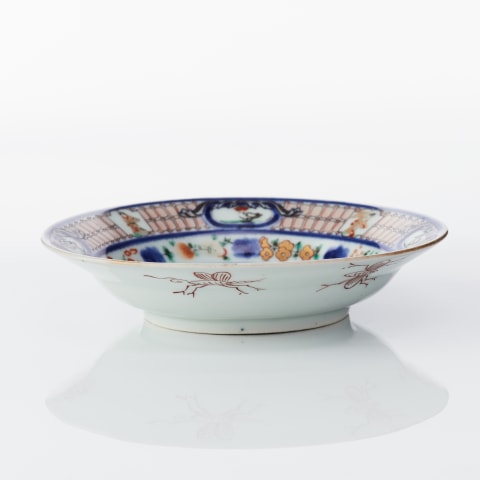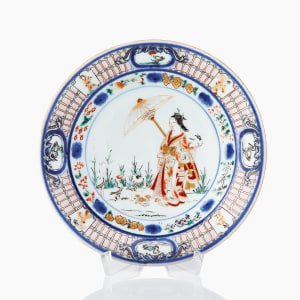BH61
Of saucer form with deep sides, decorated in the Japanese imari palette, painted following the 'Pronk' design of a lady walking in the shade of a gilt parasol held by her attendant behind her, feeding three colourful waterbirds on the bank of a river, the border with figural and bird cartouches on a honey-comb pattern ground, the reverse with seven flying insects in iron red.
Literature
Cornelis Pronk was born in Amsterdam in 1691. From 1734 to 1740 he was employed by the Dutch East India Company (V.O.C.), which commissioned sets of drawings for Chinese and Japanese porcelain. In 'Pronk Porcelain', 1980, Groninger Museum Press pp.14-36, C. J. A. Jörg discusses in detail the four designs that are generally accepted to have been drafted by Pronk, the prototypes of which can be found in the Rijksmuseum.
It is likely that the design on this dish, known as 'Dame au Parasol', was the first to be completed, having been sent to China and Japan in 1736. Likely to have been completed in 1734, It is the only 'Pronk' design found in both Chinese and Japanese porcelain. This meticulously hand-decorated dish would have had a high production price, and as such only a small number of Pronk pieces were ever made. Pronk pieces are therefore highly prized and extremely rare.
For a Japanese imari example, see C.J.A. Jorg, Pronk Porcelain, pl.35, pp. 71‑3; T. Volker, The Japanese Porcelain Trade of the Dutch East India Company after 1683, (Leiden, 1959), p. 78‑81; and see Soame Jenyns, Japanese Porcelain, (London, 1965), pl. 46A.
For a Chinese plate bearing this design, see Jorg, Chinese Export Porcelain, Chine de Commande, from the Royal Museum of Art and History in Brussels, published 1989, Pl. 45, p. 139.
There is a Chinese example in the Ashmolean Museum, Oxford, click here to view (accession number EA1991.36). The Minneapolis has a Japanese example, bequeathed by Leo A. and Doris Hodroff, accession number 95.98.75, click here to view.




